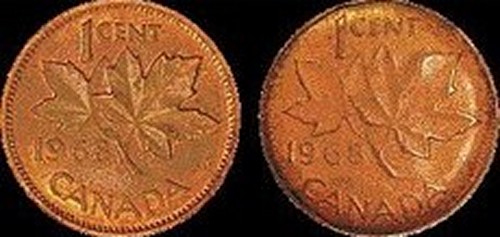Second cupped, two-tailed Canadian cent surfaces
By Mike Diamond-Special to Coin World | April 14, 2012 9:58 a.m.
Article first published in 2012-04-30, Expert Advice section of Coin World
This deeply cupped 1968 Canadian cent carries the reverse design on each face. It is almost certainly a double-struck pseudo-mule.
Images by Mike Diamond.

In the March 19 Collectors’ Clearinghouse column, I reported on a deeply cupped 1978 Canadian cent allegedly struck by two reverse dies. Considered unique at the time, it now has a companion.
After my column came out, I was contacted by Jeff Chapman who sent me photos of a nearly identical example that was struck in 1968. The presence of this second specimen further undermines the idea that either cent represents a two-tailed mule. Chapman’s cent is almost certainly a pseudo-mule that was produced under one of three scenarios described in my earlier column.
1. A cent is struck normally, flips over, and lands on top of another planchet, with the Maple Leaf design facing the planchet. A second strike flattens the original maple leaf design but does not erase it, while the hammer die obliterates the queen’s bust and simultaneously imparts the second Maple Leaf design.
2. Two planchets are struck together within the collar, creating two in-collar uniface strikes. The top coin flips over and comes to rest on the same blank surface or on top of a fresh planchet. The next strike flattens the original Maple Leaf design, while the original featureless surface is struck by the hammer die, which imparts the second Maple Leaf design.
3. A cent sporting an in-collar first-strike brockage of the Maple Leaf design on its bottom face flips over and comes to rest on the anvil die. Another planchet is inserted on top of the brockaged coin and is struck into it. The bottom face of that newly-struck coin carries a first-strike counterbrockage of the Maple Leaf design.
The second scenario would seem to be the most likely explanation for both the 1968 and 1978 cents.
Interestingly, when the 1968 cent was encapsulated by Professional Coin Grading Service, it was provided with a diagnosis entirely different from the 1978 cent. Instead of claiming it was a “die cap struck by two reverse dies,” PCGS described it as an “obverse die cap with reverse counterbrockage.”
It seems PCGS may have entertained a pseudo-mule hypothesis of its own, similar to the third scenario. It’s hard to say for sure, as the description is rather muddled. Chapman’s coin obviously cannot be an obverse die cap, since it is the reverse design that decorates the inside of the cup. Perhaps PCGS meant to call it a reverse die cap. Maybe the grading service was confused in thinking that the Maple Leaf design is on the obverse face. Or perhaps PCGS conflated the hammer die with the obverse die for the cent.
Identifying it as a die cap is easier to understand, but even this claim can be disputed. Effective striking pressure is greatly increased when two discs are stacked on top of each other. If both discs are struck out-of-collar, the top coin will curl up to surround the neck of the hammer die (see the Dec. 7, 2009, Collectors’ Clearinghouse). Only one strike is needed to form an impressive cup.
While the third scenario requires only one strike, scenarios 1 and 2 require two. But since the coin has to flip over between strikes, we still can’t consider the resulting coin a die cap. By definition, a die cap has to be affixed to the same die face through both strikes.
It seems unlikely that the flattened Maple Leaf design on either cent is a flipover, first-strike counterbrockage. Even under carefully managed conditions, the peripheral portions of any first-strike counterbrockage should be closer to the coin’s edge, and might even run off the edge of the coin.
While I haven’t encountered any cupped pseudo-mules among U.S. coins, I have seen coins that were almost certainly struck by them.
Shown here is a Lincoln cent with a perfectly centered, mid-stage flipover brockage of the obverse design on the obverse face. Struck in-collar, it was generated by a “two-headed” pseudo-mule most likely produced under the first scenario. In this case the pseudo-mule definitely became a die cap.
The next specimen is a massively expanded, broadstruck 5-cent coin with an almost perfectly centered flipover brockage of the obverse design on the obverse face. Although faint, the incuse design is complete, establishing it as a first-strike brockage. The strike that generated the brockage also undoubtedly converted the overlying 5-cent coin into a two-headed pseudo-mule (scenario No. 1).
Coin World’s Collectors’ Clearinghouse department does not accept coins or other items for examination without prior permission from News Editor William T. Gibbs. Materials sent to Clearinghouse without prior permission will be returned unexamined. Please address all Clearinghouse inquiries to cweditor@coinworld.com or to 800-673-8311, Ext. 172.
http://www.coinworld.com/articles/second-cupped-two-tailed-canadian-cent-surfac/
Copyright 2012 by Amos Hobby Publishing Inc. Reposted by permission from the March 22, 2012, issue of Coin World.)